You’re a champ at balancing your workouts. You practice yoga on Mondays, lift weights Wednesdays and Fridays, and ride your bike to work — a solid combo of strength, cardio and flexibility training. But do you ever think about balance from one side of your body to the other?
Over time, it’s easy to develop right-left asymmetries, whether because of past injuries or simply because you have a naturally dominant side. Often when you perform a bilateral movement, your stronger side compensates by taking on more of the load than your weaker side, says Jordan Metzl, MD, a sports medicine physician in New York, N.Y., and co-author of The Athlete’s Book of Home Remedies.
By practicing exercises that challenge one side of your body at a time (known as unilateral and offset exercises) you prevent muscle imbalances from developing because each side is forced to bear the load independently. You will also accrue a slew of other benefits, including these:
- Improved core strength. Picture throwing a heavy bag over one shoulder and flexing your abs on the other side of your body to keep from tipping over. Whenever you perform either an offset or unilateral exercise, you automatically recruit the muscles of your core, which include all the muscles of your trunk, says Ben Bruno, strength coach with Mike Boyle Strength and Conditioning in North Andover, Mass. “You don’t have to consciously squeeze your abs; your core reflexively activates to help you stay stable.”
- Improved efficiency and quality of movement. When you perform a unilateral or offset exercise, your muscles have to coordinate with your nervous system to control your movement and maintain your balance. This is why these types of exercises seem so challenging at first. “The fastest adaptation people have is a neurological one. It’s not that the body isn’t strong enough, it’s that the body isn’t used to firing muscles in that pattern,” says Joe Hashey, CSCS, a personal trainer in Endwell, N.Y. As the result of practicing movements that challenge your balance and proprioception, your nervous system builds new brain synapses. Net result: “Your body becomes smarter and you move more efficiently,” Hashey says.
- Injury prevention. Studies show that knee pain and lower-body overuse injuries highly correlate with weakness elsewhere. When you run, your hips and glutes work to stabilize your pelvis and prevent your knees from rotating inward. But if your glutes are not strong enough, you may compensate by overusing other muscles such as your hamstrings, says Metzl.
Single-legged exercises help prevent injuries by strengthening your hips, particularly your gluteus medius and gluteus minimus.
Most likely, you already have some experience with unilateral and offset training. A unilateral exercise, such as a lunge or a single-arm overhead press, involves loading one side of the body at a time. An offset exercise, such as a front squat with a dumbbell in one hand or a pushup with one hand elevated, involves loading more weight on one side of the body. The two can also be combined, such as a lunge with a dumbbell in one hand.
These types of exercises “are absolutely appropriate for beginners,” says Hashey. “Every time you take a step, climb stairs or reach into your trunk to pull something out, you’re using one side more than the other.”
Both Bruno and Hashey are single-side advocates, but they agree that you shouldn’t scrap your traditional bilateral moves.
Our experts recommend that you strive for a balance of bilateral, unilateral and offset exercises in your workouts. Watch the One-Sided Strength Workout video to get started, and perform the workout twice a week for four to six weeks; then incorporate the moves into your regular strength-training regimens as often as you like.
One Side Fits All
Perform three sets of 10 to 12 repetitions of each exercise on each side, unless otherwise specified. After you’ve completed both sides, rest for 45 to 60 seconds between sets.
Single-Leg Hop
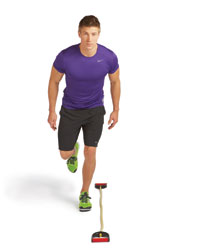

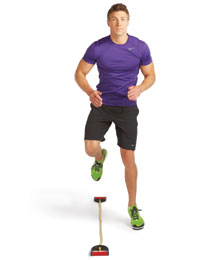
- Stand on your left leg with your weight evenly distributed throughout your foot. Bend slightly at your hips and left knee.
- Push off from the ball of your foot to hop a few inches off the ground.
- Land with your knee soft, first on the ball of your foot and then letting the rest of your foot come to the ground.
Tip: Find a low object over which to hop, such as a resistance band. Practice hopping in different directions, from side to side and front to back.
Crooked Row

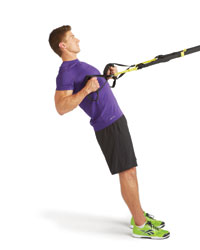
- Adjust the handles of an anchored suspension trainer such as a TRX so that one is about 4 to 6 inches longer than the other. The greater the distance, the more difficult this exercise becomes.
- Facing the anchor point, grip both handles, extend your arms in front of you and step back until the shorter of the two straps is taut.
- With your arms extended, step your feet forward, allowing the straps to support your body weight. The closer to the anchor point your feet are, the more you will have to work to pull yourself up. Keep your body in a plank position, aligned from your head to your toes.
- Focusing on the shorter handle, pull yourself up as high as you can. Keep your shoulders down, hips squared, and gaze at the anchor point. Follow through so your shoulder blades squeeze together at the end of the pull.
- Slowly lower yourself to the starting position.
Tip: If you do not have access to a suspension trainer, you can also perform this exercise using the bar from a Smith machine and two towels of unequal length. Loop the towels around the bar about shoulder-width apart. The lower you set the bar, the more challenging the exercise becomes.
Bulgarian Split Squats
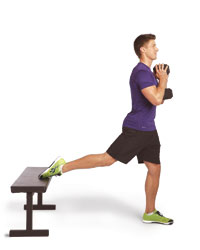
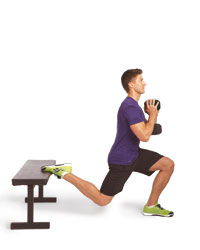
- Stand about 2 feet in front of a weight bench, facing away from it and holding a light-to-moderate- weight dumbbell (optional) in front of your chest. Stay grounded in your left foot and lift your right foot, positioning it so that the top of the foot rests on the edge of the bench. Make sure your hips are level and facing forward.
- Keeping your weight in the middle of your left foot, push your left hip back and bend your left knee to descend until your right knee is a few inches above the ground. Keep your torso upright and make sure your back remains in its natural arch. Your left knee should be directly above your left foot.
- Drive through your left midfoot to rise to the starting position.
Tip: To make it easier: Try keeping your back foot on the ground, and reduce or eliminate dumbbell weight. To make it harder: Increase dumbbell weight.
See “BREAK IT DOWN: How to Do the Bulgarian Split Squat” for more detailed instructions.
Stork Deadlift

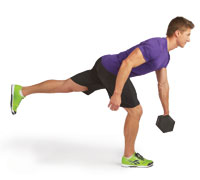
- Holding a dumbbell in your left hand, lift your left foot to stand on your right leg. Keep your right knee slightly bent and your weight in the midfoot.
- Push your right hip backward as you extend your left leg directly behind you. Maintain a straight line from your shoulder to your left foot. Lower the dumbbell toward the ground.
- Drive your weight through your right midfoot and slowly bring your left leg forward to return to an upright stance.
Tip: If you find it difficult to balance, try this exercise without the dumbbell. To get the benefits of contralateral loading (adding resistance to the arm opposite the working leg), extend your left arm out to the side (without holding a weight) while standing on your right foot.
Single-Leg Glute Bridges

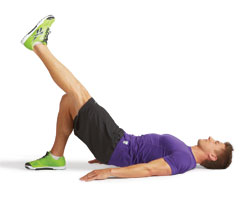
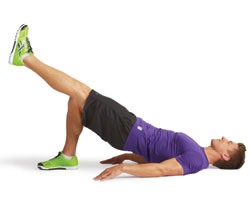
- Lie on your back with your knees bent, feet under your knees and arms at your sides.
- Push both feet into the ground to lift your hips, making sure not to excessively arch your back. Your weight should be in the heel/midfoot portion of your feet.
- Shift your weight into your right foot and lift your left leg to extend it straight in front of you. Keep your hips level. You should feel your right glutes engage.
- Slowly lower your hips so that they are just above the ground. Engage your right glutes to lift your hips. Continue lifting and lowering to complete all reps before switching sides.
Tip: If you start to feel this exercise in the front of your thighs, you might be compensating for weak glutes. For a beginner-friendly version, try Marching Bridges: Start with both feet on the ground, lift your hips, and slowly alternate lifting your right and left leg. With each repetition, focus on engaging your glutes as you press your heel into the ground.
Single-Arm Overhead Press (Progress to Walking)
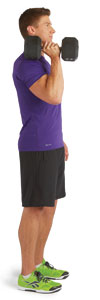


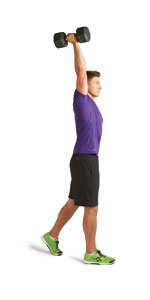
- Stand holding a dumbbell in your right hand, just outside your right ear, with your palm facing inward. Your right elbow should be at a 45-degree angle to your body.
- Extend your arm to press the dumbbell overhead. Keep your abdominals engaged and avoid arching your lower back.
- Slowly lower the dumbbell to the starting position.
Tip: Progress the exercise by walking as you perform the overhead press. Walk 20 to 30 yards before switching sides.
Lateral Bear Crawl

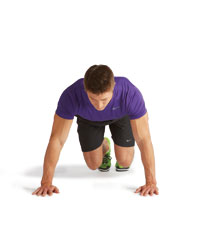
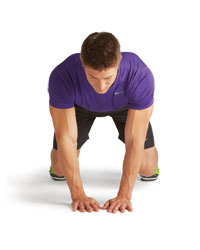
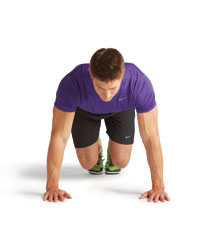
- Start on your hands and knees, with your wrists directly beneath your shoulders, your back flat and your knees directly beneath your hips.
- Lift your knees slightly so they hover about 2 inches above the ground. Simultaneously move your left foot and right hand to the left. Follow by moving your right foot and left hand to the left. Continue moving sideways about 20 to 30 yards.
- Reverse the movement to your right to return to your starting position.
Tip: You can also crawl forward or backward. Make sure to move your opposite arm and leg together and keep only two points of contact with the ground.
See all the moves in action at The One-Sided Strength Workout (Video).
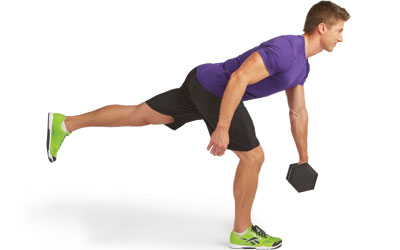

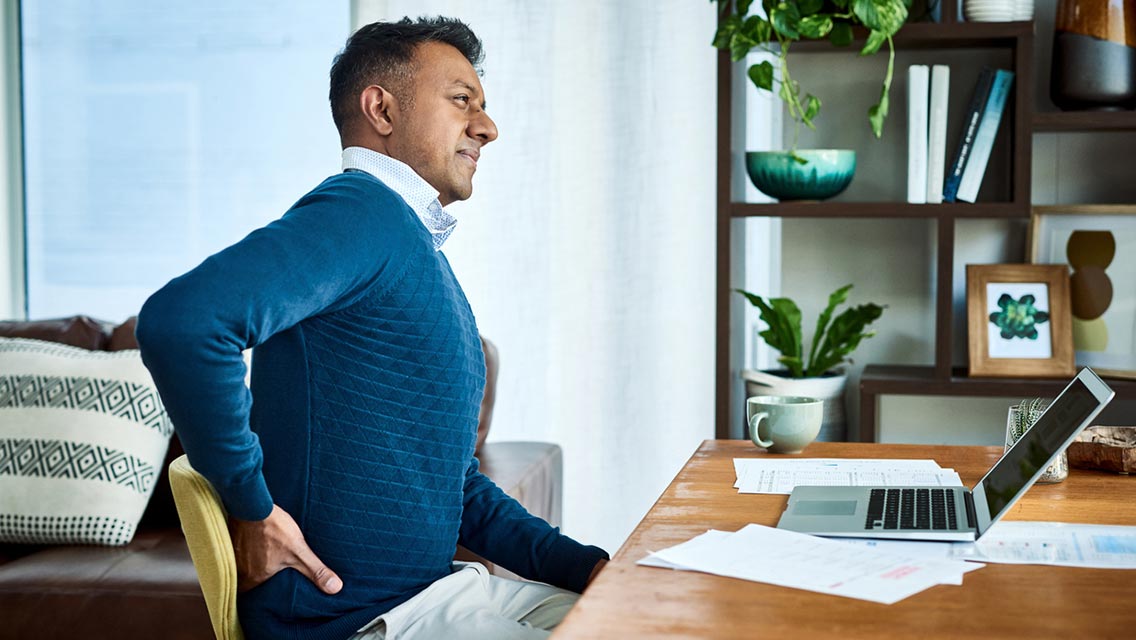
This Post Has 0 Comments